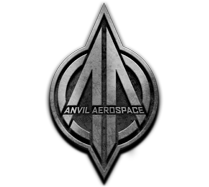For civilians, Anvil Aerospace produces small fighting craft but with less of the pirate stigma. These ships are more expensive, less spit-and-glue, and built to take more hits than a comparable Drake model. The bulk of Anvil’s income is from its military contracts with the UEE to design and build their warships, especially the iconic Hornet.[1]
Portfolio
Anvil Aerospace is one of the earliest Terran success stories. Founded in 2772, Anvil has been reliably delivering military-grade equipment to the UEE navy for almost two centuries. The initial Anvil skunkworks facility was located in Nova Kiev, Terra, and the company’s headquarters are still there. For the first seventy-odd years of Anvil’s existence, every design project was personally lead by company founder J.Harris Arnold. Arnold, an eccentric spacecraft designer of the old school who insisted on signing off on every part of his designs’ subsystems, was a beloved figure in an otherwise cutthroat industry. Today, Anvil has factories on three dozen UEE core worlds… but continues to source all systems itself and requires that the standing CEO sign off on every spacecraft alteration.
The company’s moniker comes from a quote in Robert Calvin’s famous early justification for UEE expansion, explaining that military spending “fuels the furnaces of expansion and strikes the anvils of innovation.” There’s little argument: fueling the furnaces of expansion is exactly what Anvil has been doing since Day One. The company has produced dozens of successful and iconic military spacecraft over the years, including the Hurricane, Osprey, Devastator, Hornet and Gladiator. No military campaign in the last two centuries has been launched without Anvil spacecraft in the forefront, and no carrier in UEE space today operates without at least a squadron of Anvil-designed fighters. In fact, Anvil designs have historically scored more space-to-space kills than any other military spacecraft. Hornets, in particular, have destroyed more enemy hardware (measured in star credits) than all other current Navy space fighter designed combined.[2]
Core Craft
Today, the F7A Hornet is emblematic of UEE military superiority. Hornets grace recruiting posters in every corner of the galaxy, and the lives of the fighter pilots who fly them — off of the elite Bengal carriers holding station on the frontier — are not at all unlike the stars who play them in holofilms like Chain of Command and Strike Leader. With proper tactics, Hornets have shown to be wholly effective against Vanduul raider craft, with an armament capable of delivering a stinging blow to even mid-sized Vanduul capital ships. In one recent instance, a lone Hornet assigned to shadow a fuel convoy was cornered by three raiders and was able to eliminate all three without suffering heavy damage. The pilot, name withheld for security reasons, was awarded the Navy Cross for the engagement.
Anvil also produces the Gladiator, a carrier and port-based bomber used throughout UEE space. Gladiators carry torpedoes needed to pierce heavier capital ships and installations, and are also (if increasingly rarely) used as dive-bombers in space-to-ground strike missions. With a defensive turret and drop tanks capable of unmodified cross-system travel, the Gladiator is an excellent battle platform. A high degree of configurability, rare in a military model craft, means that Gladiators can be retrofitted aboard carriers as SWACS craft, S&R ships or even trainers and target-tow craft. In spacedock, Gladiators can be fitted with everything from a jump drive (reducing bomb load) to a holo-targetting emitter. A true “where you need it” spacecraft, the Gladiator, like the Hornet, is among the UEE Navy’s most favored tools.
Civilian Craft
Anvil’s civilian line is relatively new, a decision that many at the company initially resisted. The general feeling was that producing civilian grade versions of dedicated military spacecraft would dilute the brand: Anvil’s carefully maintained position as the tip of the spear would be in danger. Debate over the issue became so protracted that it threatened to split the company into two separate groups, with the civilian wing formally licensing the military designs. This was ultimately all for naught, as the UEE government stepped into the debate with a surprising resolution: they actually favored the concept of supplying military-styled weaponry to civilians, especially on the distant frontiers. A home defense militia squadron of slightly-less-than-milspec but still fearsome Hornets, it was reasoned, would make a better deterrent than a squad of Drake Cutlasses.
The process of civilianizing a design like the Hornet is more complex than it seems: UEE military secrecy laws mean that, on average, 60% of the hardware in a given spacecraft simply cannot be offered to the public. Some of these replacements — like milspec Gatling guns — would be expected and relatively easy to re-source in a modern modular design … but these requirements also govern systems as innocuous as rudder pedal boot locks or rubber cockpit sealing strips. Design teams must effectively work double-blind, replacing existing systems without being given access to their military equivalents.In some cases, designers must reconstruct subsystems based solely on publicly available holographs … while the team that designed the original systems operates next door, wholly unaware.
Civilianizing top-of-the-line military spacecraft is a frustrating process, but one that has proved ultimately valuable for Anvil: company profits rose 34% after the first civilian model Hornet (the F7C) was made available, with no perceptible tarnishing of the Anvil brand. Rather, the idea that you could own a “military” ship immediately became something of a status symbol, driving the resale value of Hornets and successive conversions; civilian Hornets have essentially (and unexpectedly) become a luxury brand. Anvil’s civilian equivalents sell both to actual paramilitary units on the frontier desperately in need of rugged hardware and to rich homeworlds industrialists who believe that flying a Hornet makes them top gun fighter pilots.[2]
The Future
With both military and civilian spacecraft spending at an all-time high, Anvil’s prospects look bright. As the UEE continues to face off against a seemingly growing Vanduul threat, orders for Hornet space superiority fighters and Gladiator bombers continue to spike. Several thousand of each are delivered to front-line carriers every month, at a rate that continues to rise as additional factories can be brought online. On the civilian side, the Hornet is holding steady as the third best-selling single-seat spacecraft design available, trumped only by the Aurora and 300i.The recent civilian conversion of the Gladiator looks to be a similar success story, as the first model (Gladiator I) becomes available to the general public in the next three months.[2]
Anvil Aerospace Products
Ships
- Arrow
- Carrack variants
- Carrack
- Carrack Expedition
- Carrack Expedition w/C8X
- Carrack w/C8X
- Crucible
- Hornet variants
- Gladiator
- Hawk
- Hurricane
- Pisces variants
- Terrapin
- Valkyrie variants
Ground Vehicles
Thrusters
References
- ↑ RobertsSpaceIndustries.com
- ↑ 2.0 2.1 2.2 RobertsSpaceIndustries.com
- ↑ 3.0 3.1 Template:RSIShipSpecs

